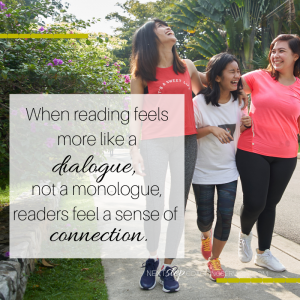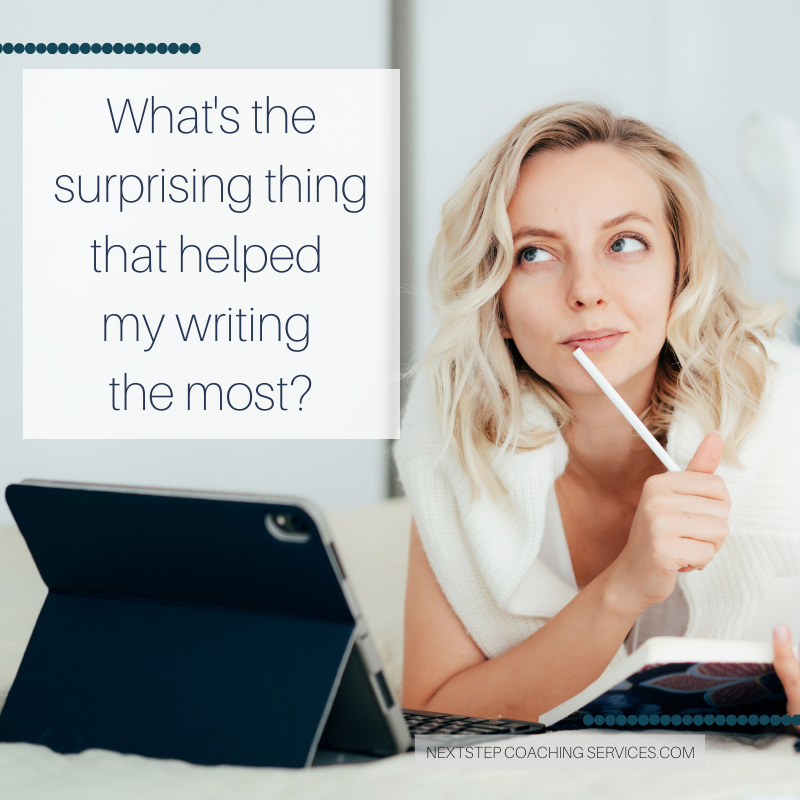How to Create a Connection with Our Readers
We discussed how important it is for writers to connect with their readers in last week’s post. Let’s continue with that topic.
Here are three ways to create a connection with our readers.
Reading is a dialogue, not a monologue
If we think of writing as a dialogue between reader and writer, not a monologue, we’re going to create a connection.
Addressing the reader with a question is a way to create a dialogue.
Have you ever felt that way?
Can you relate to these feelings?
Or an inclusive statement:
Maybe you’ve been in this place before.
Maybe you feel stuck but don’t know how to move beyond.
Do you see how this creates a dialogue, sense of going back and forth, like a conversation?
Readers want their needs recognized and their pain points addressed
Raising godly kids; caretaking, helping a friend going through breast cancer; finding freedom from addiction; learning how to study Scripture; breaking free from performance-based living.
These are topics readers are dealing with and are causing them to look for a solution in our books.
Let’s remember that most readers read to find a solution. Does your book address their need or pain point? Sometimes the solution comes in understanding, sometimes in pointed advice, sometimes both.
Example from You’ll Get Through This by Max Lucado
“So can you. You’ve been jilted and bruised, sold out and turned away. Stranded on the sandbar of bad health, bad credit, bad luck. Few friends and fewer solutions.”
Understanding words. Lucado addresses the pain. As a reader going through a hard time, you’re reading and thinking, yes, yes, yes.
Then Lucado offers advice.
“Can we talk candidly for a moment? Egypt can be a cruddy place. No one disagrees with that. But Egypt can also be the petri dish for brainless decisions. Don’t make matters worse by doing something you’ll regret.”
I love this example! Lucado delivers some direct advice—basically calling me possibly brainless. But he does it in a way I can absorb because he’s first expressed understanding.
Readers want to go on a journey with the writer when reading a book
I once read part of a parenting book by a writer who made me feel talked “at,” instead of including me in the journey of parenting. He used the pronoun “you,” meaning he was writing in second-person point of view.
Read this example written in second-person point of view:
“You should make sure your parenting decisions about consequences are age-appropriate. In general you should give younger children shorter, immediate consequences while you should give older children consequences that last longer. For example, you can give a toddler a timeout, but you can give a middle schooler a few days of a break from her electronic devices.”
This author wrote the entire book using the second-person point of view, using the pronoun you. Honestly, it was offputting to me and I stopped reading. I felt lectured.
Note that there’s nothing grammatically wrong with the above example. And certainly, there are times to use the second-person point of view. But let’s use it sparingly.
There’s a better way to write the above example. How? Use the first-person plural point of view, using pronouns like we, our, and us.
Example using first-person plural point of view:
“We need to make sure our parenting decisions about consequences are age-appropriate. In general younger children need shorter, immediate consequences while older children can understand the ramifications of longer consequences. For example, we might give a toddler a timeout, but we can give a middle schooler a few days of a break from her electronic devices.”
Do you hear the difference? I used the pronouns we and our, instead of you and your.
Take a look at your writing. Are you writing in a way that seems like a conversation? Are you acknowledging pain points and needs? Are you writing in with an understanding tone? These are just a few key ways to make your reader want to go on a journey with you and to continue reading.
~ Melanie







Hmm. That is a great example. I struggle with balancing the “I’s” and “my’s” with the “we’s” and “our’s” … and “you’s”. Thank you for this tip!
So glad it helped!